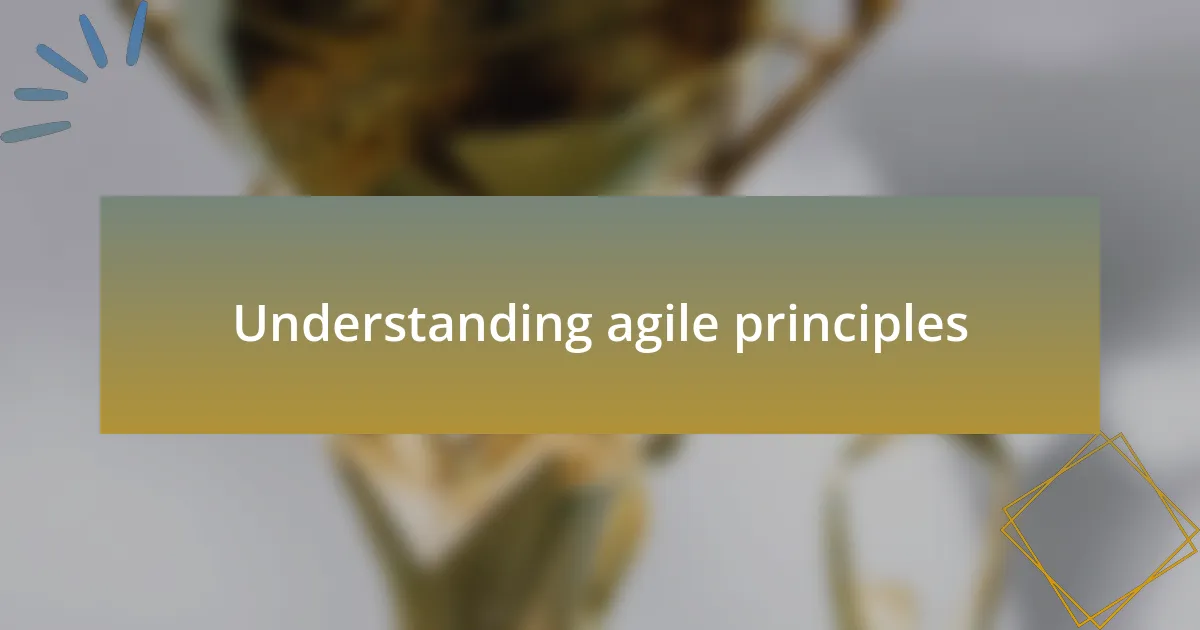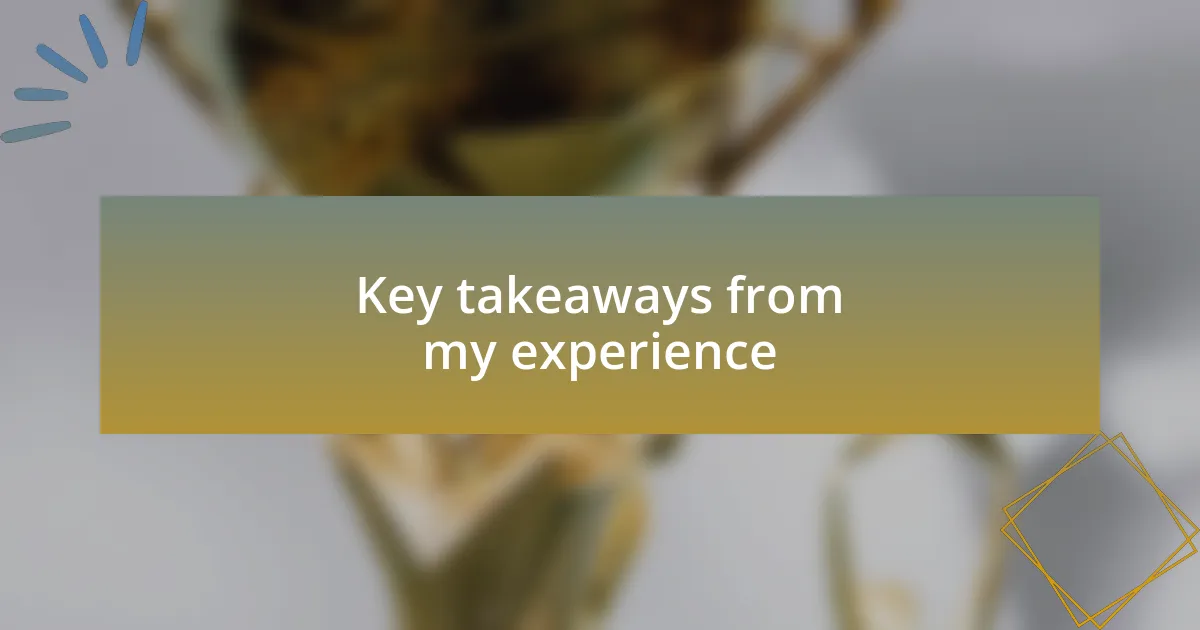Key takeaways:
- Agile methodologies prioritize flexibility and collaboration, enabling teams to adapt quickly to changes and feedback.
- Continuous learning and retrospectives foster a culture of improvement, enhancing teamwork and innovation.
- Experiencing failures as opportunities for growth helps teams refine their approaches and encourages resilience.
- Effective communication and alignment among stakeholders are essential to navigate challenges and maintain project momentum.

Overview of agile methodologies
Agile methodologies are frameworks that prioritize flexibility and collaboration over rigid planning. I remember the first time I encountered Agile at a project kick-off meeting; it transformed my approach to teamwork. The emphasis on constant feedback made me realize how much I thrived in an environment where everyone’s voice was valued.
At its core, Agile is about breaking projects into small, manageable units called “sprints.” Each sprint allows for regular reassessment and adaptation, which I found refreshing. Have you ever felt stuck in a long-term plan that just isn’t working? Agile really offers a way to pivot quickly, which can be energizing.
Principles such as customer collaboration and responsiveness shape the Agile mindset. I can’t help but reflect on how this approach mirrors the fast-paced nature of the music industry. Just like a band adjusting their setlist based on audience reactions, Agile encourages teams to stay responsive and innovative, allowing creativity to flourish amidst change.

Benefits of agile methodologies
Agile methodologies foster a culture of continuous learning and improvement. I’ve had the experience of leading a project where each sprint culminated in a retrospective, allowing the team to identify what worked and what didn’t. It felt invigorating to watch our process evolve in real time, almost like a live performance where every show refined our skills for the next.
Enhanced collaboration is another remarkable benefit of Agile. I distinctly remember a project where cross-functional teams came together, breaking down silos that usually hindered creativity. The synergy created a buzz, similar to the electric atmosphere you feel in a recording studio when every musician brings their unique sound, leading to something extraordinary.
Moreover, Agile provides the flexibility to adapt to changing circumstances. I have been part of initiatives that required quick shifts due to unexpected challenges. The ability to pivot effectively made me appreciate how adaptive the music industry needs to be, constantly responding to trends and audience preferences, much like Agile teams adjust their course based on feedback.

Understanding agile principles
Understanding agile principles is crucial for anyone looking to implement this approach effectively. At its core, Agile emphasizes individuals and interactions over processes and tools. I recall a time when our team had lengthy meetings laden with rigid agendas. Shifting to Agile made those gatherings more dynamic and interactive, which fostered a sense of trust and openness that we had previously lacked. It felt liberating, akin to letting go of strict musical notation to improvise and explore new harmonies together.
Another fundamental principle is that Agile values working software over comprehensive documentation. In one particularly challenging project, I found myself caught up in the documentation trap, focusing too much on creating the perfect manual. When we transitioned to an Agile mindset, I experienced the joy of delivering functional product increments more frequently, providing immediate value. This reminded me of how musicians rehearse and refine their pieces in front of live audiences—every performance teaches you what resonates and what needs adjustment.
Additionally, Agile encourages responding to change rather than following a fixed plan. I remember feeling apprehensive during a project when a significant change was requested just weeks from the deadline. However, by embracing this flexibility, our team crafted something even better than I had initially imagined. It was like collaborating on a song that evolved into something more profound as we navigated the challenges together, proving that sometimes, spontaneity can lead to the most remarkable outcomes.

My journey with agile practices
My journey with Agile practices began with a sense of curiosity mixed with skepticism. In our first sprint, I was amazed by how a simple daily stand-up transformed our workflow. Instead of feeling like I was part of a monotonous machine, each meeting became a stage where every voice mattered. This shift sparked a realization: isn’t it surprising how small adjustments can yield such a profound impact on team dynamics?
As we continued to embrace Agile, I found that the emphasis on collaboration resonated deeply with my musical background. I once participated in a collaborative songwriting session, and it was fascinating to witness how everyone’s unique contributions blended to create something beautiful. In the Agile framework, I experienced that same magic, where the open exchange of ideas ignited creativity, much like a jam session where improvisation leads to unexpected brilliance. Why does it feel so exhilarating when we relinquish control and allow our teammates to shine?
Reflecting on my Agile journey, I can’t help but appreciate the emotional resilience it nurtured in our team. There were moments when feedback stung, reminding me of a harsh critique after a performance. Yet, rather than retreating, I learned to view those moments as opportunities for growth, much like refining a rough draft into a polished song. In embracing Agile, I discovered not just a methodology, but a mindset that encourages vulnerability and continuous improvement. How could such an approach not resonate within the creative process?

Challenges faced in agile
Engaging with Agile methodologies isn’t without its challenges. I recall a sprint where we had high hopes for a new feature, but as conversations unfolded, it became clear that stakeholders’ expectations were misaligned. This led to a frustrating realization: disappointment can rise quickly when communication falters. How do teams effectively navigate complex discussions without losing momentum?
Another hurdle I faced was adapting to constant change. Initially, I reveled in the flexibility, but over time, I noticed my team struggling with shifting priorities. It felt like being in a band where the setlist keeps changing, making it tough to get into the rhythm. Isn’t there a balance to be struck between adaptability and stability that we often overlook?
Time management proved to be a persistent challenge, too. In one particularly chaotic sprint, I felt the pressure mounting as deadlines loomed. Collaboration should fuel creativity, not stifle it. I often wondered, can we truly innovate when we’re racing against the clock, or does that urgency dim the spark of inspiration?

Success stories in agile projects
Success stories in agile projects are often the shining moments that remind us of why we embrace this methodology. I remember one particular instance where our team launched a new music app feature that included a user-requested playlist functionality. By involving users early and often through feedback sessions, the end result exceeded our expectations. Isn’t it incredible how user collaboration can transform an idea into something truly remarkable?
Another success story that stands out in my experience was when a project team managed to double its production without sacrificing quality. This was achieved by implementing daily stand-ups, fostering accountability and transparency among team members. Watching everyone align their efforts felt like a well-conducted orchestra, each person contributing to a harmonious final product. Isn’t it fascinating how a simple adjustment in communication can lead to such impressive outcomes?
I also had a chance to observe a cross-functional team that tackled an immense challenge—revamping a legacy platform. They broke down the project into manageable sprints, celebrating small wins along the way. Each sprint completed felt like a shot of adrenaline, boosting morale and motivating the team to push through hurdles. Have you ever experienced that rush of accomplishment when you see things coming together piece by piece? It truly exemplifies the power of agile practices in turning daunting projects into achievable successes.

Key takeaways from my experience
Emphasizing the importance of teamwork in agile methodologies was one of my key takeaways. During one project, I witnessed how fostering an environment of trust and open communication empowered my colleagues to voice their ideas without hesitation. It’s remarkable to see how a supportive atmosphere can lead to innovative solutions and a collective sense of ownership, isn’t it?
Another insight I gathered is that flexibility is crucial. I remember a moment when we had to pivot away from our original plan due to unexpected user feedback. Instead of feeling lost, our team embraced the change and adapted quickly, transforming potential frustration into an opportunity for growth. Have you ever had to adjust your course mid-project? I found that embracing change instead of resisting it is often the key to success.
Lastly, celebrating failures along with successes has been transformative for me. I used to dread setbacks, but I learned to view them as stepping stones rather than roadblocks. One memorable instance was when a feature we launched didn’t perform as expected; instead of dwelling on it, our team analyzed what went wrong and utilized those insights to refine our approach. It’s refreshing to recognize that every misstep can lead us closer to our ultimate goal, wouldn’t you agree?